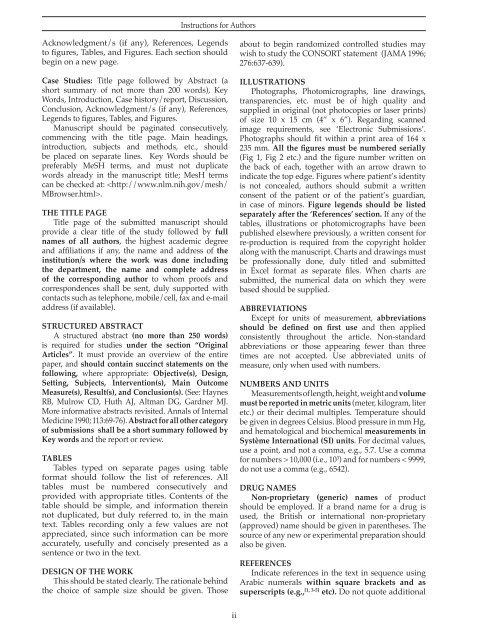Vol 41 # 3 September 2009 - Kma.org.kw
Vol 41 # 3 September 2009 - Kma.org.kw
Vol 41 # 3 September 2009 - Kma.org.kw
You also want an ePaper? Increase the reach of your titles
YUMPU automatically turns print PDFs into web optimized ePapers that Google loves.
Instructions for Authors<br />
Acknowledgment/s (if any), References, Legends<br />
to figures, Tables, and Figures. Each section should<br />
begin on a new page.<br />
Case Studies: Title page followed by Abstract (a<br />
short summary of not more than 200 words), Key<br />
Words, Introduction, Case history/report, Discussion,<br />
Conclusion, Acknowledgment/s (if any), References,<br />
Legends to figures, Tables, and Figures.<br />
Manuscript should be paginated consecutively,<br />
commencing with the title page. Main headings,<br />
introduction, subjects and methods, etc., should<br />
be placed on separate lines. Key Words should be<br />
preferably MeSH terms, and must not duplicate<br />
words already in the manuscript title; MesH terms<br />
can be checked at: .<br />
THE TITLE PAGE<br />
Title page of the submitted manuscript should<br />
provide a clear title of the study followed by full<br />
names of all authors, the highest academic degree<br />
and affiliations if any, the name and address of the<br />
institution/s where the work was done including<br />
the department, the name and complete address<br />
of the corresponding author to whom proofs and<br />
correspondences shall be sent, duly supported with<br />
contacts such as telephone, mobile/cell, fax and e-mail<br />
address (if available).<br />
STRUCTURED ABSTRACT<br />
A structured abstract (no more than 250 words)<br />
is required for studies under the section “Original<br />
Articles”. It must provide an overview of the entire<br />
paper, and should contain succinct statements on the<br />
following, where appropriate: Objective(s), Design,<br />
Setting, Subjects, Intervention(s), Main Outcome<br />
Measure(s), Result(s), and Conclusion(s). (See: Haynes<br />
RB, Mulrow CD, Huth AJ, Altman DG, Gardner MJ.<br />
More informative abstracts revisited. Annals of Internal<br />
Medicine 1990; 113:69-76). Abstract for all other category<br />
of submissions shall be a short summary followed by<br />
Key words and the report or review.<br />
TABLES<br />
Tables typed on separate pages using table<br />
format should follow the list of references. All<br />
tables must be numbered consecutively and<br />
provided with appropriate titles. Contents of the<br />
table should be simple, and information therein<br />
not duplicated, but duly referred to, in the main<br />
text. Tables recording only a few values are not<br />
appreciated, since such information can be more<br />
accurately, usefully and concisely presented as a<br />
sentence or two in the text.<br />
DESIGN OF THE WORK<br />
This should be stated clearly. The rationale behind<br />
the choice of sample size should be given. Those<br />
about to begin randomized controlled studies may<br />
wish to study the CONSORT statement (JAMA 1996;<br />
276:637-639).<br />
ILLUSTRATIONS<br />
Photographs, Photomicrographs, line drawings,<br />
transparencies, etc. must be of high quality and<br />
supplied in original (not photocopies or laser prints)<br />
of size 10 x 15 cm (4” x 6”). Regarding scanned<br />
image requirements, see ‘Electronic Submissions’.<br />
Photographs should fit within a print area of 164 x<br />
235 mm. All the figures must be numbered serially<br />
(Fig 1, Fig 2 etc.) and the figure number written on<br />
the back of each, together with an arrow drawn to<br />
indicate the top edge. Figures where patient’s identity<br />
is not concealed, authors should submit a written<br />
consent of the patient or of the patient’s guardian,<br />
in case of minors. Figure legends should be listed<br />
separately after the ‘References’ section. If any of the<br />
tables, illustrations or photomicrographs have been<br />
published elsewhere previously, a written consent for<br />
re-production is required from the copyright holder<br />
along with the manuscript. Charts and drawings must<br />
be professionally done, duly titled and submitted<br />
in Excel format as separate files. When charts are<br />
submitted, the numerical data on which they were<br />
based should be supplied.<br />
ABBREVIATIONS<br />
Except for units of measurement, abbreviations<br />
should be defined on first use and then applied<br />
consistently throughout the article. Non-standard<br />
abbreviations or those appearing fewer than three<br />
times are not accepted. Use abbreviated units of<br />
measure, only when used with numbers.<br />
NUMBERS AND UNITS<br />
Measurements of length, height, weight and volume<br />
must be reported in metric units (meter, kilogram, liter<br />
etc.) or their decimal multiples. Temperature should<br />
be given in degrees Celsius. Blood pressure in mm Hg,<br />
and hematological and biochemical measurements in<br />
Système International (SI) units. For decimal values,<br />
use a point, and not a comma, e.g., 5.7. Use a comma<br />
for numbers > 10,000 (i.e., 10 3 ) and for numbers < 9999,<br />
do not use a comma (e.g., 6542).<br />
DRUG NAMES<br />
Non-proprietary (generic) names of product<br />
should be employed. If a brand name for a drug is<br />
used, the British or international non-proprietary<br />
(approved) name should be given in parentheses. The<br />
source of any new or experimental preparation should<br />
also be given.<br />
REFERENCES<br />
Indicate references in the text in sequence using<br />
Arabic numerals within square brackets and as<br />
superscripts (e.g., [1, 3-5] etc). Do not quote additional<br />
ii
















